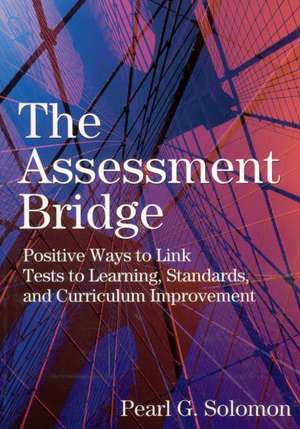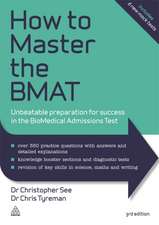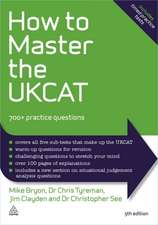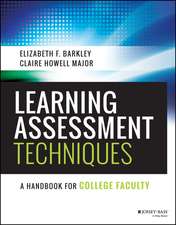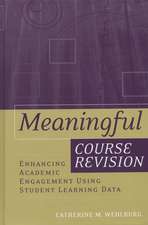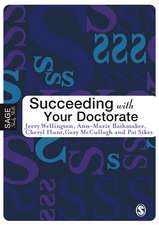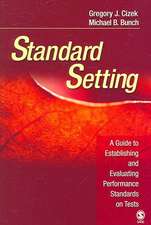The Assessment Bridge: Positive Ways to Link Tests to Learning, Standards, and Curriculum Improvement
Autor Pearl G. Solomonen Limba Engleză Paperback – 29 aug 2002
A clear-headed and cogent analysis of how High-Stakes Standards-Based (HSSB) tests affect student learning, teacher training, curriculum and instruction, and school administration and leadership. Covers the origins and history of the current testing movement and analyzes how the proper balance of standardized tests, curriculum standards, and locally controlled variables (socioeconomic status, class size, teacher attitudes) can help schools focus their energies for maximum effect and build bridges from test anxiety to better learning and better schools.
| Toate formatele și edițiile | Preț | Express |
|---|---|---|
| Paperback (1) | 279.72 lei 6-8 săpt. | |
| SAGE Publications – 29 aug 2002 | 279.72 lei 6-8 săpt. | |
| Hardback (1) | 451.01 lei 6-8 săpt. | |
| SAGE Publications – 13 aug 2002 | 451.01 lei 6-8 săpt. |
Preț: 279.72 lei
Nou
Puncte Express: 420
Preț estimativ în valută:
53.53€ • 58.13$ • 44.97£
53.53€ • 58.13$ • 44.97£
Carte tipărită la comandă
Livrare economică 23 aprilie-07 mai
Preluare comenzi: 021 569.72.76
Specificații
ISBN-13: 9780761945949
ISBN-10: 0761945946
Pagini: 180
Dimensiuni: 178 x 254 x 11 mm
Greutate: 0.34 kg
Ediția:New.
Editura: SAGE Publications
Colecția Corwin
Locul publicării:Thousand Oaks, United States
ISBN-10: 0761945946
Pagini: 180
Dimensiuni: 178 x 254 x 11 mm
Greutate: 0.34 kg
Ediția:New.
Editura: SAGE Publications
Colecția Corwin
Locul publicării:Thousand Oaks, United States
Recenzii
"Just the kind of bridge we need to span the ideological wars and make schools work for teachers and their students."
"In her supremely well-written and useful book, Dr. Solomon has woven together historical perspective, research, and her own considerable experience to address reforming schools in the 21st Century. After defining the problem (productive change), Dr. Solomon has examined "old" solutions and conceptualized new ones to create better schools for students. She has focused the reader's attention on critical issues to be addressed--restructuring curriculum around assessment to inform instruction; selecting, training, and retaining the best teachers; and developing shared leadership--and has offered useful and practical suggestions to address them."
"Standards and implementation of the learning process go hand in hand. The Assessment Bridge makes us clearly aware of the present need for a bridge between the two so that standards may not create greater failure and the rejection of formal education by many children."
"This book presents the needed material to follow from Dr. Solomon’s work on standards and curriculum. It completes the bridge from goals to accountability by introducing a better understanding of assessment. It will allow educators to better comprehend the key instructional issues that we face."
"Dr. Solomon's latest is, once again, a gem. The Assessment Bridge offers a wealth of concrete tools and examples to support schools, administrators, and teachers in providing meaningful student learning experiences in (and despite) a high-stakes testing environment. Her reflections and inquiry on her own teaching and learning experiences are woven throughout, and present a unique context and historical perspective that somehow make this task possible. It will be high on my list of recommended resource books."
"In her supremely well-written and useful book, Dr. Solomon has woven together historical perspective, research, and her own considerable experience to address reforming schools in the 21st Century. After defining the problem (productive change), Dr. Solomon has examined "old" solutions and conceptualized new ones to create better schools for students. She has focused the reader's attention on critical issues to be addressed--restructuring curriculum around assessment to inform instruction; selecting, training, and retaining the best teachers; and developing shared leadership--and has offered useful and practical suggestions to address them."
"Standards and implementation of the learning process go hand in hand. The Assessment Bridge makes us clearly aware of the present need for a bridge between the two so that standards may not create greater failure and the rejection of formal education by many children."
"This book presents the needed material to follow from Dr. Solomon’s work on standards and curriculum. It completes the bridge from goals to accountability by introducing a better understanding of assessment. It will allow educators to better comprehend the key instructional issues that we face."
"Dr. Solomon's latest is, once again, a gem. The Assessment Bridge offers a wealth of concrete tools and examples to support schools, administrators, and teachers in providing meaningful student learning experiences in (and despite) a high-stakes testing environment. Her reflections and inquiry on her own teaching and learning experiences are woven throughout, and present a unique context and historical perspective that somehow make this task possible. It will be high on my list of recommended resource books."
Cuprins
Foreword - by Ann Lieberman
Preface
About the Author
1. Defining the Problem: The Historical Context
About This Chapter
Schools as Transmitters of Culture
What Early 20th-Century Schools Were Like
My School in Bethel
Elementary Schools in Depression-Era New York City
Education Beyond the Classroom
Schools in the Later 20th Century: A Beginning Teacher
IQ Tests and Regents Exams
Defining and Dealing With Differences
What the Research Told Us
Proving My Point: Giving Students Choices
Back to Basics
Special Education
Using History as a Decision Base
2. Schools at the Beginning of the 21st Century: Problems and Proposed Solutions
About This Chapter
Defining the Problem
Proposed Solution One: Defining Educational Standards
Proposed Solution Two: School Accountability
The Government Response: High-Stake Testing
High-Stakes Testing: The Other Stakeholders Respond
Proposed Solution Three: Achieveing Equity Through School Choice
Proposed Solution Four: Extending the Time for Schooling
Time for Enrichment
Time for a Good Start
Proposed Solution Five: Technology in the Classroom
The Research Base for Technology Use
Technology as an Assessment Tool and Manager
The Current Status of the Use of Technology in Schools
Technology for Communicating With Our Public
Some Conclusions About Technology in the Classroom
3. Taking the First Steps Toward Productive Change
About This Chapter
The Variables of Change
Vision and Voice
History and Setting
Bounded Rationality
Opportunism and Asset-Specific Investments
Step One: Building New Capacity
Step Two: Generating Ownership
Step Three: Assuming Leadership
Step Four: Providing Time for Learning and Change
Changing Schools in the Search for a Better Future
4. The Assessment Roadway: How Tests Tell Us What to Do
About This Chapter
Demonstrating Knowledge
Defining Standards and Assessment
Rubrics
The Task-Specific Rubric
The Developmental Rubric
Using Rubrics in Formative and Summative Assessment
Summative Applications
Generating Ownership of Tests
Reaching Consensus on Group Summative Scores
Matching Distal and Proximal Measures
Validity: Does It Fit?
Generating Ownership: Begin With Curriculum-Based Proximal Assessments
Preparing for the Tests: Curriculum Teaching
Proximal Measures Responding to HSSB Analyses
What Lies Beneath: Disaggregating Scores
Disaggregating for Noninstructional Differences
Relationship of Teacher Training and Experience to Student Achievement
Other Cultural and School Variables: Confronting the Achievement Gap
5. Responding to High-Stakes, Standards-Based (HSSB) Tests: Restructuring Curriculum
About This Chapter
Two Alternative Responses to HSSB Tests
Alternative One: Starting With the HSSB Test
Embedded Concepts
Assessment-Responsive Curriculum Adjustments
Starting From a Core of HSSB Tests: Applying and Responding to Analysis
Alternative Two: Starting With the Standards
Responding to Test Data With Curriculum Reconstruction
In Conclusion: Assessing Oneself
6. Building a Cohort of the Best Teachers: Recruitment, Engagement, Nurturance
About This Chapter
About Models
Why We Need to Recruit Teachers
Where Teachers Used to Come From
Why There Is a Current Shortage: The Recruitment Pool
Why There Is a Current Shortage: Retention
Solving the Prestige Problem: Interdependent Stakeholders
Solving the Prestige Problem: Changing the Agenda of Teacher Unions
Solving the Prestige Problem: Raising Teacher Salaries
The REN Model: Recruiting Heroes
The REN Model: Educating Recruits
The REN Model: Engagement in Action
The REN Model: Engagement in Interaction
The REN Model: Nurturing Novices
Nurturing Experienced Teachers: The Need for Better Professional Development
Motivating Teachers to Participate in Professional Development
A Cooperative-Teaching Model
How I Learned: Cooperative Teaching
Professional-Development Schools: Object Linking and Embedding (OLE) Relationships
An Example: The East Ramapo and St. Thomas Aquinas College PDS
Engaging in the OLE Process
Some General Conclusions About Increasing Teachers' Capacity
7. Searching for Leadership
About This Chapter
Understanding Leadership and Power
Direct and Indirect Messages
Evoking Change
Leading: Giving Power and Indirect Messages
How Educational Leaders Act
A Personal Analysis From the Distributive Perspective
Shared Leadership and Power
The Power of Money, Matches, Tradition, Time, and Place
Social Interactions, Macrotasks, and Microtasks in Curriculum Leadership Roles
Social Interactions, Macrotasks, and Microtasks in the Principal Leadership Role
The Shortage of Administrators
Leadership by Teachers
Leadership by Teacher Networks
MCMSC Network: Sample Activities
What We Learned About Leadership Needs
Addressing Sociocultural Needs: Other Sources and Focuses of Leadership
Community-Based Leadership: Project Excel
Community-Based Leadership: Windhover Farm
Using Models to Build the Assessment Bridge
Epilogue
References
Index
Preface
About the Author
1. Defining the Problem: The Historical Context
About This Chapter
Schools as Transmitters of Culture
What Early 20th-Century Schools Were Like
My School in Bethel
Elementary Schools in Depression-Era New York City
Education Beyond the Classroom
Schools in the Later 20th Century: A Beginning Teacher
IQ Tests and Regents Exams
Defining and Dealing With Differences
What the Research Told Us
Proving My Point: Giving Students Choices
Back to Basics
Special Education
Using History as a Decision Base
2. Schools at the Beginning of the 21st Century: Problems and Proposed Solutions
About This Chapter
Defining the Problem
Proposed Solution One: Defining Educational Standards
Proposed Solution Two: School Accountability
The Government Response: High-Stake Testing
High-Stakes Testing: The Other Stakeholders Respond
Proposed Solution Three: Achieveing Equity Through School Choice
Proposed Solution Four: Extending the Time for Schooling
Time for Enrichment
Time for a Good Start
Proposed Solution Five: Technology in the Classroom
The Research Base for Technology Use
Technology as an Assessment Tool and Manager
The Current Status of the Use of Technology in Schools
Technology for Communicating With Our Public
Some Conclusions About Technology in the Classroom
3. Taking the First Steps Toward Productive Change
About This Chapter
The Variables of Change
Vision and Voice
History and Setting
Bounded Rationality
Opportunism and Asset-Specific Investments
Step One: Building New Capacity
Step Two: Generating Ownership
Step Three: Assuming Leadership
Step Four: Providing Time for Learning and Change
Changing Schools in the Search for a Better Future
4. The Assessment Roadway: How Tests Tell Us What to Do
About This Chapter
Demonstrating Knowledge
Defining Standards and Assessment
Rubrics
The Task-Specific Rubric
The Developmental Rubric
Using Rubrics in Formative and Summative Assessment
Summative Applications
Generating Ownership of Tests
Reaching Consensus on Group Summative Scores
Matching Distal and Proximal Measures
Validity: Does It Fit?
Generating Ownership: Begin With Curriculum-Based Proximal Assessments
Preparing for the Tests: Curriculum Teaching
Proximal Measures Responding to HSSB Analyses
What Lies Beneath: Disaggregating Scores
Disaggregating for Noninstructional Differences
Relationship of Teacher Training and Experience to Student Achievement
Other Cultural and School Variables: Confronting the Achievement Gap
5. Responding to High-Stakes, Standards-Based (HSSB) Tests: Restructuring Curriculum
About This Chapter
Two Alternative Responses to HSSB Tests
Alternative One: Starting With the HSSB Test
Embedded Concepts
Assessment-Responsive Curriculum Adjustments
Starting From a Core of HSSB Tests: Applying and Responding to Analysis
Alternative Two: Starting With the Standards
Responding to Test Data With Curriculum Reconstruction
In Conclusion: Assessing Oneself
6. Building a Cohort of the Best Teachers: Recruitment, Engagement, Nurturance
About This Chapter
About Models
Why We Need to Recruit Teachers
Where Teachers Used to Come From
Why There Is a Current Shortage: The Recruitment Pool
Why There Is a Current Shortage: Retention
Solving the Prestige Problem: Interdependent Stakeholders
Solving the Prestige Problem: Changing the Agenda of Teacher Unions
Solving the Prestige Problem: Raising Teacher Salaries
The REN Model: Recruiting Heroes
The REN Model: Educating Recruits
The REN Model: Engagement in Action
The REN Model: Engagement in Interaction
The REN Model: Nurturing Novices
Nurturing Experienced Teachers: The Need for Better Professional Development
Motivating Teachers to Participate in Professional Development
A Cooperative-Teaching Model
How I Learned: Cooperative Teaching
Professional-Development Schools: Object Linking and Embedding (OLE) Relationships
An Example: The East Ramapo and St. Thomas Aquinas College PDS
Engaging in the OLE Process
Some General Conclusions About Increasing Teachers' Capacity
7. Searching for Leadership
About This Chapter
Understanding Leadership and Power
Direct and Indirect Messages
Evoking Change
Leading: Giving Power and Indirect Messages
How Educational Leaders Act
A Personal Analysis From the Distributive Perspective
Shared Leadership and Power
The Power of Money, Matches, Tradition, Time, and Place
Social Interactions, Macrotasks, and Microtasks in Curriculum Leadership Roles
Social Interactions, Macrotasks, and Microtasks in the Principal Leadership Role
The Shortage of Administrators
Leadership by Teachers
Leadership by Teacher Networks
MCMSC Network: Sample Activities
What We Learned About Leadership Needs
Addressing Sociocultural Needs: Other Sources and Focuses of Leadership
Community-Based Leadership: Project Excel
Community-Based Leadership: Windhover Farm
Using Models to Build the Assessment Bridge
Epilogue
References
Index
Notă biografică
Pearl G. Solomon is professor emerita of teacher education at St. Thomas Aquinas College in Sparkill, New York. She has served as a director and officer for professional organizations and as a consultant to many school districts, the New York State Education Department, and the United States Department of Education. Solomon is the recipient of a number of special awards from the state and community for her work in science, math, health, and career education.
Descriere
Award-winning educator Pearl Solomon presents a clear-headed and cogent analysis of today's high-stakes standards-based testing movement.
